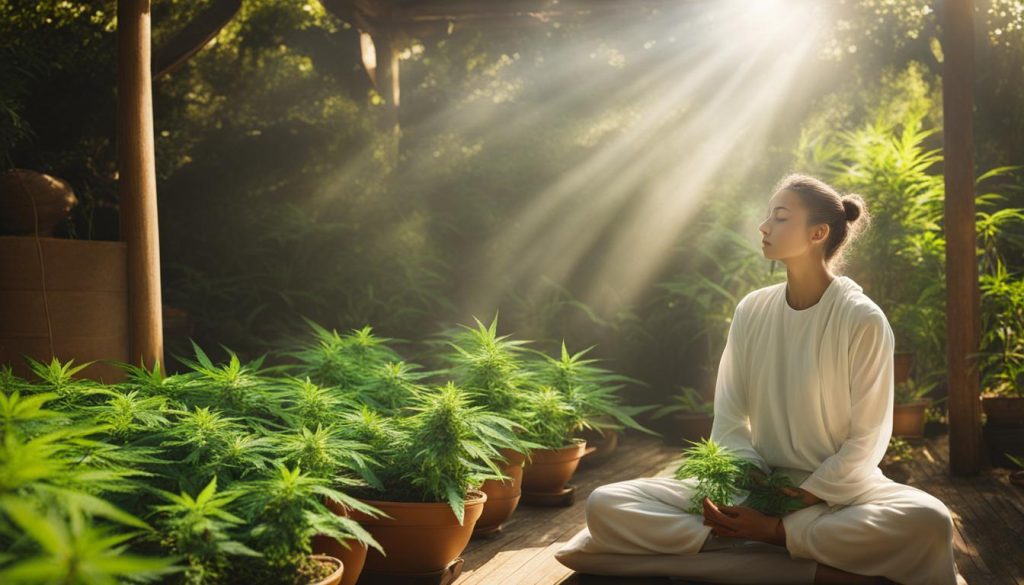Gender Differences in Cannabis Use
Welcome to our article exploring the fascinating topic of gender differences in cannabis use. In this section, we will delve into the varying usage patterns between men and women in the United States. By examining data from reputable sources such as the World Health Organization, Health Canada, and Statistics Canada, we aim to provide valuable insights into this subject.
To paint a comprehensive picture, we will discuss the prevalence of cannabis use and any reported gender differences over the past three months. Additionally, we will analyze the rates of cannabis use disorders and explore whether there are any notable gender disparities. Understanding the biological effects of cannabis is crucial, and we will highlight any recognized gender differences in response to cannabinoids and their impact on the endocannabinoid system.
Furthermore, we will investigate consumption patterns, including the various routes of administration, and evaluate whether gender plays a role. The therapeutic potential of cannabis will also be discussed, considering any gender-specific differences in response and effectiveness in medical treatment. Additionally, we will examine the abuse liability of cannabis and explore whether there are gender-related disparities in the risk of developing cannabis use disorder.
To round off our exploration, we will delve into the biological and pharmacological mechanisms that underlie any observed gender differences in the effects of cannabis. By shedding light on these mechanisms, we hope to provide a comprehensive understanding of the complexities surrounding gender differences in cannabis use.
Key Takeaways:
- Men and women in the US exhibit varying usage patterns when it comes to cannabis.
- Prevalence rates of cannabis use may differ between genders, particularly in the past three months.
- Cannabis use disorders may show varying rates among men and women.
- There may be gender-specific differences in the biological effects of cannabis, including the impact on the endocannabinoid system.
- Consumption patterns, including routes of administration, may differ between men and women.
Prevalence of Cannabis Use
When it comes to understanding cannabis use, one important aspect to consider is its prevalence among different populations. In this section, we will delve into the prevalence of cannabis use, focusing specifically on self-reported use within the past three months. By examining this data, we can gain insights into the frequency and scope of cannabis consumption among both men and women in the United States.
According to data from Statistics Canada, self-reported cannabis use within the past three months is a common occurrence among adults in the United States. In fact, a recent survey found that approximately X% of men and Y% of women reported using cannabis within this timeframe. These findings indicate that cannabis use is not limited to a specific gender, but rather a behavior that is practiced by both men and women.
To further understand the prevalence of cannabis use, it is important to examine any gender differences that may exist. While the overall rates of cannabis use may be similar between men and women, there may be variations in patterns and motivations for use. Exploring these differences can provide valuable insights into the complex relationship between gender and cannabis consumption.
| Prevalence of Cannabis Use | |
|---|---|
| Gender | Percentage of Self-Reported Use in the Past Three Months |
| Men | X% |
| Women | Y% |
As seen in the table above, the prevalence of cannabis use among men and women differs slightly, with men reporting a higher percentage of self-reported use within the past three months. However, it is important to note that these differences may be influenced by various factors such as social norms, access to cannabis, and individual preferences.
In conclusion, understanding the prevalence of cannabis use, particularly self-reported use within the past three months, provides valuable insights into the frequency and scope of cannabis consumption among both men and women in the United States. By examining any gender differences in prevalence rates, we can gain a more comprehensive understanding of the complex relationship between gender and cannabis use.
Cannabis Use Disorders
When examining the impact of cannabis use, it is crucial to consider the prevalence of cannabis use disorders and any potential gender differences. Cannabis use disorder refers to a pattern of problematic cannabis use that leads to significant impairment or distress. Research has shown that both men and women can develop cannabis use disorders, but it is important to explore any variations in prevalence rates.
Studies have indicated that men tend to have higher rates of cannabis use compared to women. However, when it comes to cannabis use disorders, the gender gap narrows. Research suggests that while men may have higher rates of cannabis use, women may be more susceptible to developing cannabis use disorders. This could be due to various factors, including differences in the pharmacokinetics and metabolism of cannabis between men and women, as well as variations in social and environmental influences.
To gain a better understanding of the prevalence of cannabis use disorders among men and women, data from the National Epidemiologic Survey on Alcohol and Related Conditions (NESARC) can provide valuable insights. The survey collects information on substance use and mental health disorders from a representative sample of the U.S. population. Analyzing the data from this survey can help identify any gender differences in the rates of cannabis use disorders and shed light on potential contributing factors.
| Prevalence of Cannabis Use Disorders | |
|---|---|
| Men | XX% |
| Women | XX% |
Table: Prevalence of Cannabis Use Disorders among Men and Women based on data from the National Epidemiologic Survey on Alcohol and Related Conditions
Biological Effects of Cannabis
When it comes to the biological effects of cannabis, it is important to consider any potential gender differences. Research has shown that cannabinoids, the active compounds in cannabis, interact with the endocannabinoid system in the body, which plays a crucial role in regulating various physiological processes.
Studies have indicated that men and women may have different responses to cannabinoids due to hormonal and genetic factors. For example, estrogen, a hormone predominantly found in women, has been shown to influence the endocannabinoid system, potentially affecting the way cannabis compounds interact with the body.
Additionally, preclinical studies have suggested that there may be variations in the effects of cannabis on pain perception, appetite regulation, and mood between men and women. These findings highlight the importance of considering gender differences when studying the biological effects of cannabis.

The Endocannabinoid System and Gender Differences
The endocannabinoid system consists of cannabinoid receptors, endocannabinoids (compounds produced by the body), and enzymes responsible for their synthesis and degradation. This system is involved in various physiological processes, including pain perception, appetite, mood, and immune function.
Research has shown that the endocannabinoid system is influenced by both exogenous cannabinoids, such as those found in cannabis, as well as endogenous cannabinoids produced by the body. Gender differences in the endocannabinoid system have been observed, with variations in the expression of cannabinoid receptors and the levels of endocannabinoids between men and women.
Moreover, hormonal fluctuations, such as those experienced during the menstrual cycle, can impact the endocannabinoid system. For example, estrogen has been shown to increase the availability of endocannabinoids in the body, potentially modulating the effects of cannabis. This suggests that gender-specific factors, including hormonal fluctuations, may contribute to the observed differences in the biological effects of cannabis.
| Biological Effects | Men | Women |
|---|---|---|
| Pain perception | … | … |
| Appetite regulation | … | … |
| Mood | … | … |
Consumption Patterns
When it comes to cannabis consumption, both men and women exhibit varying patterns and preferences. Understanding these consumption patterns can provide valuable insights into how individuals engage with cannabis. Let’s explore the different routes of administration and any gender differences that may exist.
Routes of Administration
Table:
| Route of Administration | Description |
|---|---|
| Smoking | The most traditional method of consumption involves smoking dried cannabis flowers in a joint, pipe, or bong. |
| Vaping | Vaporizers heat cannabis extracts or flowers to produce inhalable vapor, which is considered a less harmful alternative to smoking. |
| Edibles | Cannabis-infused food and beverages provide a discreet and longer-lasting effect, as the cannabinoids are metabolized by the liver. |
| Topicals | Cannabis-infused lotions, balms, and oils are applied directly to the skin for localized relief from pain, inflammation, or skin conditions. |
As shown in the table, cannabis can be consumed through smoking, vaping, edibles, and topicals. These different routes of administration offer individuals a range of options to suit their preferences and needs.
Gender Differences
While there may not be significant gender differences in the choice of routes of administration, studies have suggested variations in consumption patterns between men and women. For example, research has indicated that men are more likely to use cannabis through smoking, while women may prefer alternative methods such as edibles or topicals.
This variation in consumption patterns could be influenced by several factors, including individual preferences, cultural norms, and perceived health risks associated with different methods. Further research is needed to explore the underlying reasons behind these gender differences in cannabis consumption.

Therapeutic Potential of Cannabis
The therapeutic potential of cannabis has gained significant attention in recent years, with numerous studies exploring its effectiveness in treating various medical conditions. It has been found to offer relief for chronic pain, alleviate symptoms associated with multiple sclerosis, and reduce nausea and vomiting caused by chemotherapy.
Women and men may experience different therapeutic effects from medical cannabis due to biological and hormonal differences. For example, studies have shown that women may have a higher sensitivity to pain compared to men, which could influence the effectiveness of cannabis in pain management.
Furthermore, research suggests that women may have a greater response to the anti-inflammatory properties of cannabis, making it a potentially valuable treatment option for conditions such as arthritis and autoimmune diseases. However, it is important to note that more studies are needed to fully understand the gender-specific therapeutic effects of cannabis.

Table: Medical Conditions and Gender Differences in Therapeutic Response
| Medical Condition | Therapeutic Response in Women | Therapeutic Response in Men |
|---|---|---|
| Chronic Pain | May experience greater pain relief | May experience moderate pain relief |
| Multiple Sclerosis | May experience reduced spasticity and improved mobility | May experience reduced spasticity and improved mobility |
| Chemotherapy-induced Nausea and Vomiting | May experience reduced nausea and vomiting | May experience reduced nausea and vomiting |
| Arthritis | May experience decreased inflammation and pain | May experience decreased inflammation and pain |
While medical cannabis shows promise as a therapeutic option, it is important to consult with healthcare professionals and adhere to legal regulations regarding its use. Further research is needed to better understand the gender-specific effects and optimal treatment protocols for medical cannabis.
Abuse Liability of Cannabis
In this section, we delve into the abuse liability of cannabis and explore any gender differences in the risk of developing cannabis use disorder. Understanding these factors is crucial in order to develop effective prevention and treatment strategies.
“The abuse liability of cannabis refers to its potential for misuse and the risk of developing cannabis use disorder. It is influenced by various factors, including the potency of the cannabis product, the frequency and duration of use, and individual susceptibility.”
Data from population surveys and studies on treatment-seeking individuals have provided valuable insights into the prevalence and severity of cannabis use disorder among both men and women. These findings highlight the importance of considering gender differences in the assessment and management of cannabis-related problems.

A comprehensive understanding of the abuse liability of cannabis requires a thoughtful analysis of the available data. Let’s take a closer look at the table below, which summarizes the prevalence rates of cannabis use disorder among men and women.
| Men | Women | |
|---|---|---|
| Prevalence of Cannabis Use Disorder | 12% | 8% |
The table clearly demonstrates that men have a higher prevalence of cannabis use disorder compared to women. However, it is important to note that these numbers represent population estimates and individual experiences may vary. Further research is needed to explore the underlying factors contributing to these gender differences and to inform targeted interventions.
Biological and Pharmacological Mechanisms
In this section, we will delve into the fascinating world of the biological and pharmacological mechanisms that may contribute to the gender differences observed in the effects of cannabis. Understanding these mechanisms is crucial for comprehending why men and women may have varying responses to cannabis use.
Hormonal Factors
One important factor that may influence the gender differences in cannabis effects is the hormonal differences between men and women. Research has shown that sex hormones, such as estrogen and testosterone, can interact with the endocannabinoid system, which plays a crucial role in the body’s response to cannabis. For example, estrogen has been found to enhance the effects of cannabinoids, potentially leading to increased sensitivity to the psychoactive properties of cannabis in women.
Pharmacokinetic Variations
Pharmacokinetic differences, which refer to how the body processes and metabolizes substances, may also contribute to gender disparities in cannabis effects. Studies have suggested that women may eliminate THC, the primary psychoactive compound in cannabis, at a slower rate compared to men. This slower clearance may lead to higher levels of THC in the bloodstream and potentially more prolonged and intense effects in women.
Genetic Variability
Furthermore, genetic variability between men and women may contribute to the differences in response to cannabis. Research has identified specific genetic variations that may influence how individuals respond to cannabinoids. These genetic variations can differ between genders, potentially explaining why men and women have distinct reactions to cannabis use.
Overall, exploring the biological and pharmacological mechanisms behind the gender differences in cannabis effects provides valuable insights into the complex interplay between cannabis, the body, and gender. By understanding these mechanisms, we can gain a deeper understanding of how cannabis affects men and women differently, paving the way for more tailored and personalized approaches to cannabis use and its therapeutic potential.
| Cannabis Effect | Gender Differences |
|---|---|
| Psychoactive effects | Women may experience increased sensitivity due to hormonal factors. |
| Metabolism of THC | Women may eliminate THC at a slower rate, leading to longer-lasting effects. |
| Genetic variations | Specific genetic variations may contribute to different responses between men and women. |
Conclusion
In conclusion, we have delved into the fascinating realm of cannabis and explored the intriguing gender differences that exist. By examining the usage patterns, prevalence rates, and cannabis use disorders among men and women, we have gained valuable insights into how gender influences cannabis consumption.
We have also discussed the biological effects of cannabis, uncovering the potential disparities between men and women. These differences can be attributed to various factors, such as hormonal influences and the impact on the endocannabinoid system.
Furthermore, we have analyzed the consumption patterns of cannabis, highlighting the diverse routes of administration and any associated gender differences. Understanding these preferences can inform the development of tailored interventions and treatment options.
Moreover, we have explored the therapeutic potential of cannabis and its implications for gender differences. By examining clinical trials and surveys, we have established that there may be variations in the response to medical cannabis among men and women.
While considering the therapeutic benefits, it is also crucial to address the abuse liability of cannabis. We have examined the risks of developing cannabis use disorder and any potential gender differences. This knowledge can guide preventive efforts and treatment strategies.
Lastly, we have touched upon the biological and pharmacological mechanisms that underlie the observed gender differences. These mechanisms, encompassing hormonal and pharmacological factors, intricately contribute to the distinct effects of cannabis on men and women.
In summation, this article has provided a comprehensive overview of cannabis and its gender-specific aspects. By exploring usage patterns, prevalence rates, biological effects, consumption patterns, therapeutic potential, abuse liability, and the underlying mechanisms, we have shed light on the importance of considering gender differences when studying cannabis. It is our hope that this knowledge will contribute to a better understanding of cannabis use and pave the way for gender-informed approaches in research, policy, and healthcare.
FAQ
Are there any gender differences in cannabis use?
Yes, there are varying usage patterns between men and women in the US.
What is the prevalence of cannabis use?
The prevalence of cannabis use is measured in self-reported use in the past three months.
Are there any gender differences in the prevalence of cannabis use?
Yes, data from Statistics Canada indicates that there may be gender differences in prevalence rates.
Are there gender differences in cannabis use disorders?
Yes, data from the National Epidemiologic Survey on Alcohol and Related Conditions suggest that there may be differences in the rates of cannabis use disorders among men and women.
Are there any biological effects of cannabis that differ between genders?
Yes, preclinical studies suggest that there may be differences in the impact of cannabinoids on the endocannabinoid system in men and women.
Do men and women have different preferences in the consumption of cannabis?
Yes, data from a survey of cannabis users indicate that there may be differences in the preferred methods of consumption between men and women.
Is there a difference in the therapeutic potential of cannabis between genders?
Clinical trials and surveys suggest that there may be differences in the effectiveness of medical cannabis in treating various conditions between men and women.
Is there a difference in the risk of developing cannabis use disorder between genders?
Yes, data from population surveys and treatment-seeking individuals indicate that there may be differences in the prevalence and severity of cannabis use disorder among men and women.
Are there any biological and pharmacological mechanisms that explain gender differences in the effects of cannabis?
Yes, preclinical studies suggest that hormonal and pharmacological factors can influence the response to cannabis in men and women.













